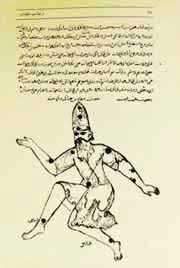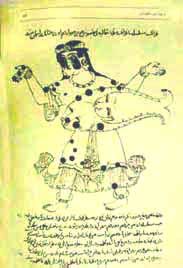|

Summer 2001 (9.2)
A 13th-Century Darwin?
Tusi's
Views on Evolution
by Farid
Alakbarli
  Nasiraddin Tusi (also
known as Nasir ad-Din Tusi) was born in 1201 in Tus, Khorasan,
in what is now Iran. As a scientist and all-around genius, he
is known for many things: founding an observatory in Maragha
(the ancient cultural center situated in Maragha which is east
of Tabriz in present-day Iran), interpreting and developing the
mathematics of Euclid, predicting the existence of land west
of the Atlantic Ocean as well as writing more than 80 influential
books in Arabic and Persian about astronomy, geometry, geography,
physics, law, history, medicine, philosophy, logic and ethics.
Today he is highly revered and honored in Azerbaijan, and several
education institutions are named after him, including the Tusi
Pedagogical Institute in Baku. Nasiraddin Tusi (also
known as Nasir ad-Din Tusi) was born in 1201 in Tus, Khorasan,
in what is now Iran. As a scientist and all-around genius, he
is known for many things: founding an observatory in Maragha
(the ancient cultural center situated in Maragha which is east
of Tabriz in present-day Iran), interpreting and developing the
mathematics of Euclid, predicting the existence of land west
of the Atlantic Ocean as well as writing more than 80 influential
books in Arabic and Persian about astronomy, geometry, geography,
physics, law, history, medicine, philosophy, logic and ethics.
Today he is highly revered and honored in Azerbaijan, and several
education institutions are named after him, including the Tusi
Pedagogical Institute in Baku.
What few people know, however, is that Tusi also developed a
basic theory of evolution - more than 600 years before Charles
Darwin.
This theory appears in Tusi's popular work "Akhlag Nasiri"
(Nasirean Ethics), a treatise on ethics in the Greek tradition
built upon the 11th century "Tahdhib al-Akhlag of Ibn Miskawayh",
which Tusi drafted in prison while being held by the Assassins,
a religious terrorist group. He later revised it for his Mongol
master (the Mongolian occupation led to his release from prison).
"Nasirean Ethics" was translated into English by G.M.
Wickens and published by George Allen & Unwin in 1964.
"Akhlag Nasiri" is about the perfection of humans.
Tusi divides this perfection into two parts - material and spiritual
perfection. He uses the term "takamul", which means
"perfection" in Arabic. In modern Azeri, this same
term now means "evolution".
  Different Approach Different Approach
Various evolutionary ideas existed before Tusi's time, as shown
in the folklore and religious beliefs of certain Oriental peoples,
including the Babylonians, Egyptians and Medians. However, these
ideas were more mythological than scientific. They were later
adopted and expanded upon by ancient Greek scholars such as Empedocles
(490-430 BC) and Aristotle (384-322 BC).
Aristotle wrote: "Nature gradually, step by step, develops
from inanimate substances to living creatures." Muslim scholars
such as Abu Reihan Biruni (972-1048), Ibn Bajja (1070-1138) and
Ibn Tufail (1110-1185) later tried to develop Aristotle's evolutionary
views.
Left
and Below: Tusi
is most remembered for his work in astronomy and the Observatory
that was built in Maragha (present-day Iran). These pages from
medieval manuscripts include sketches of constellations drawn
by his own hand. These days it is difficult to identify which
constellations are intended as the Arabic names do not coincide
with modern
Tusi used their works as the basis for a chapter of "Akhlag
Nasiri", foreshadowing the theories of European scientists
like Jean-Baptiste de Lamarck (1744-1829) and Charles Darwin
(1809-1882).
There are some key differences between Tusi's approach and Darwin's
"The Origin of Species". While Darwin used deductive
reasoning, gathering samples of plants and animals to work his
way from facts to a theory, Tusi used a more theoretical approach.
Muslim scholars like Tusi relied on inductive reasoning, moving
from theory to facts, instead of the other way around. He developed
a theory and then explained the facts on the basis of this theory.
When he wrote about evolution (he called it "perfection")
as a theory, he therefore didn't dwell on the details. For instance,
he didn't write specifically about natural selection or the struggle
for existence. In modern terms, he was more of a philosopher
than a scientist.
  Conservation of Matter Conservation of Matter
While this reasoning may seem backward to today's Western mind,
some of Tusi's theories did have merit. For instance, Tusi believed
that a body of matter is able to change, but is not able to entirely
disappear. He wrote: "A body of matter cannot disappear
completely. It only changes its form, condition, composition,
color and other properties and turns into a different complex
or elementary matter." His views were similar to those of
the ancient Greek philosopher Heraclitus (530-470 BC).
Five hundred years later, M. Lomonosov (1711-1765) and Antoine-Laurent
Lavoisier (1743-1794) created the law of conservation of mass,
setting down this very same idea.
First Stage of
Evolution
Tusi believed that the world once consisted of similar elements.
He wrote: "They were equal and similar to each other. None
of them had an advantage over the others, because all of these
particles consisted of common primary matter."
From the modern point of view, it is possible to identify Tusi's
primary particles as atoms or elementary particles. According
to Tusi, in this first stage, all of the particles were similar
and immobile. Later, internal contradictions gradually appeared
inside this static world. Tusi wrote: "As a result, the
balance was damaged, and the essential contrasts began to appear
inside this early world. Therefore, some substances began to
develop faster and better than others."
Tusi said that primary matter was the first link of the evolutionary
chain. The four elements of Nature (fire, water, air and ground)
were derived from this primary matter. In turn, minerals came
from elements, plants from minerals, animals from plants, and
humans from animals.
  Variability Variability
Tusi explained that hereditary variability was the leading force
of evolution. He wrote that all living organisms were able to
change and that the animate organisms developed owing to their
hereditary variability: "The organisms that can gain the
new features faster are more variable. As a result, they gain
advantages over other creatures." This sounds remarkably
like a simplistic form of Darwin's writings about mutations.
Why do these bodies of matter change? Tusi was right when he
suggested: "The bodies are changing as a result of the internal
and external interactions" - that is, as a result of environmental
influences.
According to Tusi, substances compete with each other, so some
of them have reached a higher level than others. Some bodies
do not develop at all. Therefore, there are different levels
of development in Nature.
Adaptation
Tusi noticed that organisms have unique ways of surviving. If
an organism's structure corresponds to the environment, he said,
that organism is perfect. He believed that all animals and plants
in the world were perfect, because they all have the properties
that are necessary to survive. Tusi wrote: "Look at the
world of animals and birds. They have all that is necessary for
defense, protection and daily life, including strengths, courage
and appropriate tools [organs]".
Tusi wrote that animate organisms are adapted to the environment
in different ways. At first, they can change the shape and structure
of their bodies. Thus, each part of the body has its own function.
"Some of these organs are real weapons," he wrote.
"For example, horns-spear, teeth and claws-knife and needle,
feet and hoofs-cudgel. The thorns and needles of some animals
are similar to arrows."
In this way, some animals have changed their structure in order
to adapt to a certain environment. Some animals have also adapted
in terms of their behavior. Tusi wrote: "Animals that have
no other means of defense (as the gazelle and fox) protect themselves
with the help of flight and cunning."
Tusi also described social animals, which are forced to live
together to protect themselves from the pressure of the environment.
He wrote: "Some of them, for example, bees, ants and some
bird species, have united in communities in order to protect
themselves and help each other."
Plant and Animal
Origins
Tusi identified three groups of animate beings in Nature: plants,
animals and humans. What distinguishes them? According to Tusi,
"Animals are higher than plants, because they are able to
move consciously, go after food, find and eat useful things."
Advanced (higher) animals also have a [primitive] capability
of reasoning and can easily adapt to their environment. If the
environmental conditions change, the higher animals will change
their behavior as well.
"There are many differences between the animal and plant
species," Tusi wrote. "First of all, the animal kingdom
is more complicated. Besides, reason is the most beneficial feature
of animals. Owing to reason, they can learn new things and adopt
new, non-inherent abilities. For example, the trained horse or
hunting falcon...is at a higher point of development in the animal
world. The first steps of human perfection begin from here."
Origin of Humans
Tusi believed that humans were derived from advanced animals.
He wrote about the different transition forms between the human
and animal world, saying: "Such humans [probably anthropoid
apes] live in the Western Sudan and other distant corners of
the world. They are close to animals by their habits, deeds and
behavior."
Tusi said that humans are related to all living and inanimate
creatures of Nature: "The human has features that distinguish
him from other creatures, but he has other features that unite
him with the animal world, vegetable kingdom or even with the
inanimate bodies."
As to the differences, Tusi wrote that humans are not only biological,
but also social beings: "Before [the creation of humans],
all differences between organisms were of the natural origin.
The next step will be associated with spiritual perfection, will,
observation and knowledge."
According to Tusi, humans are distinct from animals because they
are able to make professional tools (instruments). In conclusion,
Tusi wrote: "All these facts prove that the human being
is placed on the middle step of the evolutionary stairway. According
to his inherent nature, the human is related to the lower beings,
and only with the help of his will can he reach the higher development
level."
Allegory or Science?
So why isn't Tusi widely known for developing the theory of evolution?
It isn't just because he was from the East and wrote in Persian.
Tusi's theory is based on philosophy and Islam. He believed that
God created the world, and that after creation occurred, the
world developed on its own, while God supervises and guides this
process.
As a result, Eastern scientists who are familiar with Tusi's
views about the perfection of the world have tended to interpret
them from a religious or philosophical point of view. Many Muslims
don't agree with the theory of evolution, just as some Christians
don't, because it contradicts official theology. Although Tusi
points at some of the same principles that Darwin developed,
Eastern scientists consider Tusi's views as an allegory about
the perfection of the human soulnot as naturalistic theory.
Dr. Farid Alakbarov
first became interested in Tusi's views on evolution in 1986,
when he began his research of Arabic texts at Baku's Institute
of Manuscripts. In 2000, he wrote a booklet entitled "Nasiraddin
Tusinin takamul gorushlari" (Azeri) (The Evolutionary Views
by Nasiraddin Tusi), known as "Evolutsionniye vzglyadi Nasiraddina
Tusi" in Russian. He also presented a paper on the subject
at Azerbaijan International University's Conference Devoted to
the 800th Jubilee of Nasiraddin Tusi. Dr. Alakbarov writes a
regular feature column in AI related to medieval medicine. His
previous articles are available at AZER.com in English; or at
AZERI.org, in the Azeri Latin script.
See also "Scientists
Who Made a Difference: Nasir ad-din Tusi and the Maragha Observatory" by Dr. Chingiz Gajar
in Azerbaijan International (AI 4.2), Summer 1996, page 35.
_____
From Azerbaijan
International
(9.2) Summer 2001.
© Azerbaijan International 2001. All rights reserved.
|




